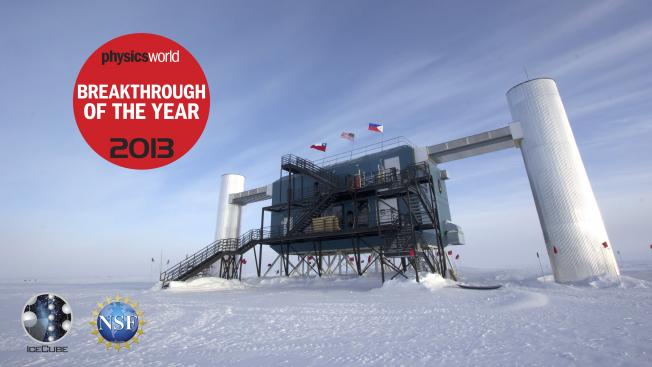Deployment of the IceCube Upgrade Camera System in the SPICEcore hole
Sissa Medialab Srl (2021) 1047
Authors:
Christoph Toennis, Rasha Abbasi, Markus Ackermann, Jenni Adams, Juanan Aguilar, M Ahlers, Maryon Ahrens, Cyril Martin Alispach, Antonio Augusto Alves Junior, Najia Moureen Binte Amin, Rui An, Karen Andeen, Tyler Anderson, Gisela Anton, Carlos Arguelles, Yosuke Ashida, Spencer Axani, Xinhua Bai, Aswathi Balagopal V., Anastasia Maria Barbano, SW Barwick, Benjamin Bastian, Vedant Basu, Sebastian Baur, RC Bay, JJ Beatty, K-H Becker, Julia Becker Tjus, Chiara Bellenghi, Segev BenZvi, D Berley, Elisa Bernardini, DZ Besson, Gary Binder, Daniel Bindig, E Blaufuss, Summer Blot, Matthias Boddenberg, Federico Bontempo, Jurgen Borowka, S Boser, Olga Botner, Jakob Boettcher, Etienne Bourbeau, Federica Bradascio, J Braun, Stephanie Bron, Jannes Brostean-Kaiser, Sally-Ann Browne, Alexander Burgman, Ryan T Burley, Raffaela Busse, Michael Campana, Erin Carnie-Bronca, Chujie Chen, Dmitry Chirkin, Koun Choi, Brian Clark, Kenneth Clark, Lew Classen, Alan Coleman, Gabriel Collin, JM Conrad, Paul Coppin, Pablo Correa, DF Cowen, R Cross, Christian Dappen, Pranav Dave, Catherine DE CLERCQ, James DeLaunay, Hans Dembinski, Kunal Deoskar, Sam De Ridder, Abhishek Desai, Paolo Desiati, Krijn de Vries, Gwenhaël de Wasseige, Meike De With, Tyce DeYoung, Sukeerthi Dharani, Alejandro Diaz, Juan Carlos Diaz-Velez, Markus Dittmer, Hrvoje Dujmovic, Matt Dunkman, Michael DuVernois, Emily Dvorak, Thomas Ehrhardt, Philipp Eller, Ralph Engel, Hannah Erpenbeck, John Evans, PA Evenson, Kwok Lung Fan, AR Fazely, Sebastian Fiedlschuster, Aaron Fienberg, Kirill Filimonov, Chad Finley, Leander Fischer, Derek B Fox, Anna Franckowiak, Elizabeth Friedman, Alexander Fritz, Philipp Furst, TK Gaisser, Jay Gallagher, Erik Ganster, Alfonso Garcia, Simone Garrappa, L Gerhardt, Ava Ghadimi, Christian Glaser, Theo Glauch, Thorsten Glusenkamp, A Goldschmidt, Javier Gonzalez, Sreetama Goswami, Darren Grant, Timothée Grégoire, Spencer Griswold, Mehmet Gunduz, Christoph Günther, Christian Haack, Allan Hallgren, R Halliday, L Halve, F Halzen, Martin Ha Minh, Kael Hanson, John Hardin, Alexander A Harnisch, Andreas Haungs, Simon Hauser, Dustin Hebecker, K Helbing, Felix Henningsen, Emma C Hettinger, Stephanie Hickford, Joshua Hignight, Colton Hill, GC Hill, Kara Hoffman, Ruth Hoffmann, Tobias Hoinka, Benjamin Hokanson-Fasig, K Hoshina, Feifei Huang, Matthias Huber, Thomas Huber, Klas Hultqvist, Mirco Hunnefeld, Raamis Hussain, Seongjin In, Nadège Iovine, Aya Ishihara, Matti Jansson, George Japaridze, Minjin Jeong, Ben Jones, Donghwa Kang, Woosik Kang, Xinyue Kang, Alexander Kappes, David Kappesser, Timo Karg, Martina Karl, A Karle, U Katz, M Kauer, Moritz Kellermann, JL Kelley, Ali Kheirandish, Ken'ichi Kin, Thomas Kintscher, Joanna Kiryluk, Spencer Klein, Ramesh Koirala, Hermann Kolanoski, Tomas Kontrimas, Lutz Kopke, Claudio Kopper, Sandro Kopper, DJ Koskinen, Paras Koundal, Michael Kovacevich, Marek Kowalski, Tetiana Kozynets, Emma Kun, Naoko Kurahashi Neilson, Neha Navnitkumar Lad, Cristina Lagunas Gualda, Justin Lanfranchi, Michael J Larson, Frederik Hermann Lauber, Jeffrey Lazar, Jiwoong Lee, Kayla Leonard, Agnieszka Leszczynska, Yijia Li, Massimiliano Lincetto, Qinrui Liu, Maria Liubarska, Elisa Lohfink, Cristian Jesus Lozano Mariscal, Lu Lu, Francesco Lucarelli, Andrew Ludwig, William Luszczak, Yang Lyu, Wing Yan Ma, James Madsen, Kendall Mahn, Yuya Makino, Sarah Mancina, Ioana Codrina Maris, Reina H Maruyama, K Mase, Thomas McElroy, Frank McNally, James Vincent Mead, K Meagher, Andres Medina, Maximilian Meier, Stephan Andrew Meighen-Berger, Jessie Micallef, Daniela Mockler, Teresa Montaruli, Roger Moore, R Morse, Marjon Moulai, Richard Naab, Ryo Nagai, Uwe Naumann, Jannis Necker, Le Viet Nguyen, Hans Niederhausen, Mehr Nisa, Sarah Nowicki, Dave Nygren, Anna Obertacke Pollmann, Marie Oehler, A Olivas, Erin O'Sullivan, Hershal Pandya, Daria Pankova, Nahee Park, Grant Parker, Ek Narayan Paudel, Larissa Paul, Carlos Perez de los Heros, Lilly Peters, Josh Peterson, Saskia Philippen, Damian Pieloth, Sarah Pieper, Martin Pittermann, A Pizzuto, M Plum, Yuiry Popovych, Alessio Porcelli, Maria Prado Rodriguez, P Buford Price, Brandom Pries, Gerald Przybylski, Christoph Raab, Amirreza Raissi, Mohamed Rameez, K Rawlins, Immacolata Carmen Rea, Abdul Rehman, Patrick Reichherzer, René Reimann, Giovanni Renzi, Elisa Resconi, Simeon Reusch, Wolfgang Rhode, Mike Richman, Benedikt Riedel, Ella Roberts, Sally Robertson, Gerrit Roellinghoff, Martin Rongen, Carsten Rott, Tim Ruhe, Dirk Ryckbosch, Devyn Rysewyk Cantu, Ibrahim Safa, Julian Saffer, Sebastian Sanchez Herrera, Alexander Sandrock, Joakim Sandroos, Marcos Santander, Subir Sarkar, Sourav Sarkar, Konstancja Satalecka, Maximilian Karl Scharf, Merlin Schaufel, Harald Schieler, Sebastian Schindler, P Schlunder, Torsten Schmidt, Austin Schneider, Judith Schneider, Frank G Schröder, Lisa Johanna Schumacher, Georg Schwefer, Steve Sclafani, D Seckel, Surujhdeo Seunarine, Ankur Sharma, S Shefali, Manuel Silva, Barbara Skrzypek, Ben Smithers, Robert Snihur, Jan Soedingrekso, Dennis Soldin, Christian Spannfellner, Glenn Spiczak, Christian Spiering, Juliana Stachurska, Michael Stamatikos, T Stanev, Robert Stein, Joeran Stettner, A Steuer, T Stezelberger, Timo Sturwald, Thomas Stuttard, GW Sullivan, I Taboada, Frederik Tenholt, Samvel Ter-Antonyan, S Tilav, Franziska Tischbein, Kirsten Tollefson, Lenka Tomankova, Christoph Tönnis, Simona Toscano, Delia Tosi, Alexander Trettin, Maria Tselengidou, Chunfai Tung, Andrea Turcati, Roxanne Turcotte, Colin Turley, Jean Pierre Twagirayezu, Bunheng Ty, Martin Unland Elorrieta, Nora Valtonen-Mattila, Justin Vandenbroucke, Nick van Eijndhoven, David Vannerom, Jakob van Santen, Stef Verpoest, Matthias Vraeghe, C Walck, Timothyblake Watson, Chris Weaver, Philip Weigel, Andreas Weindl, Matthew Weiss, Jan Weldert, Chris Wendt, Johannes Werthebach, Mark Weyrauch, Nathan Whitehorn, CH Wiebusch, Dawn Williams, Martin Wolf, Kurt Woschnagg, Gerrit Wrede, Johan Wulff, Xianwu Xu, Yiqian Xu, Juan Pablo Yanez, S Yoshida, Shiqi Yu, Tianlu Yuan, Zelong ZhangDesign of an Efficient, High-Throughput Photomultiplier Tube Testing Facility for the IceCube Upgrade
Sissa Medialab Srl (2021) 1056
Authors:
Lasse Halve, Rasha Abbasi, Markus Ackermann, Jenni Adams, Juanan Aguilar, M Ahlers, Maryon Ahrens, Cyril Martin Alispach, Antonio Augusto Alves Junior, Najia Moureen Binte Amin, Rui An, Karen Andeen, Tyler Anderson, Gisela Anton, Carlos Arguelles, Yosuke Ashida, Spencer Axani, Xinhua Bai, Aswathi Balagopal V., Anastasia Maria Barbano, SW Barwick, Benjamin Bastian, Vedant Basu, Sebastian Baur, RC Bay, JJ Beatty, K-H Becker, Julia Becker Tjus, Chiara Bellenghi, Segev BenZvi, D Berley, Elisa Bernardini, DZ Besson, Gary Binder, Daniel Bindig, E Blaufuss, Summer Blot, Matthias Boddenberg, Federico Bontempo, Jurgen Borowka, S Boser, Olga Botner, Jakob Boettcher, Etienne Bourbeau, Federica Bradascio, J Braun, Stephanie Bron, Jannes Brostean-Kaiser, Sally-Ann Browne, Alexander Burgman, Ryan T Burley, Raffaela Busse, Michael Campana, Erin Carnie-Bronca, Chujie Chen, Dmitry Chirkin, Koun Choi, Bryanlee Clark, Kenneth Clark, Lew Classen, Alan Coleman, Gabriel Collin, JM Conrad, Paul Coppin, Pablo Correa, DF Cowen, R Cross, Christian Dappen, Pranav Dave, Catherine DE CLERCQ, James DeLaunay, Hans Dembinski, Kunal Deoskar, Sam De Ridder, Abhishek Desai, Paolo Desiati, Krijn de Vries, Gwenhaël de Wasseige, Meike De With, Tyce DeYoung, Sukeerthi Dharani, Alejandro Diaz, Juan Carlos Diaz-Velez, Markus Dittmer, Hrvoje Dujmovic, Matt Dunkman, Michael DuVernois, Emily Dvorak, Thomas Ehrhardt, Philipp Eller, Ralph Engel, Hannah Erpenbeck, John Evans, PA Evenson, AR Fazely, Sebastian Fiedlschuster, Aaron Fienberg, Kirill Filimonov, Chad Finley, Leander Fischer, Derek B Fox, Anna Franckowiak, Elizabeth Friedman, Alexander Fritz, Philipp Furst, TK Gaisser, Jay Gallagher, Erik Ganster, Alfonso Garcia, Simone Garrappa, L Gerhardt, Ava Ghadimi, Christian Glaser, Theo Glauch, Thorsten Glusenkamp, A Goldschmidt, Javier Gonzalez, Sreetama Goswami, Darren Grant, Timothée Grégoire, Spencer Griswold, Mehmet Gunduz, Christoph Günther, Christian Haack, Allan Hallgren, R Halliday, L Halve, F Halzen, Martin Ha Minh, Kael Hanson, John Hardin, Alexander A Harnisch, Andreas Haungs, Simon Hauser, Dustin Hebecker, K Helbing, Felix Henningsen, Emma C Hettinger, Stephanie Hickford, Joshua Hignight, Colton Hill, GC Hill, Kara Hoffman, Ruth Hoffmann, Tobias Hoinka, Benjamin Hokanson-Fasig, K Hoshina, Feifei Huang, Matthias Huber, Thomas Huber, Klas Hultqvist, Mirco Hunnefeld, Raamis Hussain, Seongjin In, Nadège Iovine, Aya Ishihara, Matti Jansson, George Japaridze, Minjin Jeong, Ben Jones, Donghwa Kang, Woosik Kang, Xinyue Kang, Alexander Kappes, David Kappesser, Timo Karg, Martina Karl, A Karle, U Katz, M Kauer, Moritz Kellermann, JL Kelley, Ali Kheirandish, Ken'ichi Kin, Thomas Kintscher, Joanna Kiryluk, Spencer Klein, Ramesh Koirala, Hermann Kolanoski, Tomas Kontrimas, Lutz Kopke, Claudio Kopper, Sandro Kopper, DJ Koskinen, Paras Koundal, Michael Kovacevich, Marek Kowalski, Tetiana Kozynets, Emma Kun, Naoko Kurahashi Neilson, Neha Navnitkumar Lad, Cristina Lagunas Gualda, Justin Lanfranchi, Michael J Larson, Frederik Hermann Lauber, Jeffrey Lazar, Jiwoong Lee, Kayla Leonard, Agnieszka Leszczynska, Yijia Li, Massimiliano Lincetto, Qinrui Liu, Maria Liubarska, Elisa Lohfink, Cristian Jesus Lozano Mariscal, Lu Lu, Francesco Lucarelli, Andrew Ludwig, William Luszczak, Yang Lyu, Wing Yan Ma, James Madsen, Kendall Mahn, Yuya Makino, Sarah Mancina, Ioana Codrina Maris, Reina H Maruyama, K Mase, Thomas McElroy, Frank McNally, James Vincent Mead, K Meagher, Andres Medina, Maximilian Meier, Stephan Andrew Meighen-Berger, Jessie Micallef, Daniela Mockler, Teresa Montaruli, Roger Moore, R Morse, Marjon Moulai, Richard Naab, Ryo Nagai, Uwe Naumann, Jannis Necker, Le Viet Nguyen, Hans Niederhausen, Mehr Nisa, Sarah Nowicki, Dave Nygren, Anna Obertacke Pollmann, Marie Oehler, A Olivas, Erin O'Sullivan, Hershal Pandya, Daria Pankova, Nahee Park, Grant Parker, Ek Narayan Paudel, Larissa Paul, Carlos Perez de los Heros, Lilly Peters, Saskia Philippen, Damian Pieloth, Sarah Pieper, Martin Pittermann, A Pizzuto, M Plum, Yuiry Popovych, Alessio Porcelli, Maria Prado Rodriguez, P Buford Price, Brandom Pries, Gerald Przybylski, Christoph Raab, Amirreza Raissi, Mohamed Rameez, K Rawlins, Immacolata Carmen Rea, Abdul Rehman, Patrick Reichherzer, René Reimann, Giovanni Renzi, Elisa Resconi, Simeon Reusch, Wolfgang Rhode, Mike Richman, Benedikt Riedel, Ella Roberts, Sally Robertson, Gerrit Roellinghoff, Martin Rongen, Carsten Rott, Tim Ruhe, Dirk Ryckbosch, Devyn Rysewyk Cantu, Ibrahim Safa, Julian Saffer, Sebastian Sanchez Herrera, Alexander Sandrock, Joakim Sandroos, Marcos Santander, Subir Sarkar, Sourav Sarkar, Konstancja Satalecka, Maximilian Karl Scharf, Merlin Schaufel, Harald Schieler, Sebastian Schindler, P Schlunder, Torsten Schmidt, Austin Schneider, Judith Schneider, Frank G Schröder, Lisa Johanna Schumacher, Georg Schwefer, Steve Sclafani, D Seckel, Surujhdeo Seunarine, Ankur Sharma, S Shefali, Manuel Silva, Barbara Skrzypek, Ben Smithers, Robert Snihur, Jan Soedingrekso, Dennis Soldin, Christian Spannfellner, Glenn Spiczak, Christian Spiering, Juliana Stachurska, Michael Stamatikos, T Stanev, Robert Stein, Joeran Stettner, A Steuer, T Stezelberger, Timo Sturwald, Thomas Stuttard, GW Sullivan, I Taboada, Frederik Tenholt, Samvel Ter-Antonyan, S Tilav, Franziska Tischbein, Kirsten Tollefson, Lenka Tomankova, Christoph Tönnis, Simona Toscano, Delia Tosi, Alexander Trettin, Maria Tselengidou, Chunfai Tung, Andrea Turcati, Roxanne Turcotte, Colin Turley, Jean Pierre Twagirayezu, Bunheng Ty, Martin Unland Elorrieta, Nora Valtonen-Mattila, Justin Vandenbroucke, Nick van Eijndhoven, David Vannerom, Jakob van Santen, Stef Verpoest, Matthias Vraeghe, C Walck, Timothyblake Watson, Chris Weaver, Philip Weigel, Andreas Weindl, Matthew Weiss, Jan Weldert, Chris Wendt, Mark Weyrauch, Nathan Whitehorn, CH Wiebusch, Dawn Williams, Martin Wolf, Kurt Woschnagg, Gerrit Wrede, Johan Wulff, Xianwu Xu, Yiqian Xu, Juan Pablo Yanez, S Yoshida, Shiqi Yu, Tianlu Yuan, Zelong Zhang, Johannes WerthebachDirection Reconstruction using a CNN for GeV-Scale Neutrinos in IceCube
ArXiv 2107.02122 (2021)
Search for secluded dark matter with 6 years of IceCube data
Sissa Medialab Srl (2021) 521
Authors:
Christoph Toennis, Rasha Abbasi, Markus Ackermann, Jenni Adams, Juanan Aguilar, M Ahlers, Maryon Ahrens, Cyril Martin Alispach, Antonio Augusto Alves Junior, Najia Moureen Binte Amin, Rui An, Karen Andeen, Tyler Anderson, Gisela Anton, Carlos Arguelles, Yosuke Ashida, Spencer Axani, Xinhua Bai, Aswathi Balagopal V., Anastasia Maria Barbano, SW Barwick, Benjamin Bastian, Vedant Basu, Sebastian Baur, RC Bay, JJ Beatty, K-H Becker, Julia Becker Tjus, Chiara Bellenghi, Segev BenZvi, D Berley, Elisa Bernardini, DZ Besson, Gary Binder, Daniel Bindig, E Blaufuss, Summer Blot, Matthias Boddenberg, Federico Bontempo, Jurgen Borowka, S Boser, Olga Botner, Jakob Boettcher, Etienne Bourbeau, Federica Bradascio, J Braun, Stephanie Bron, Jannes Brostean-Kaiser, Sally-Ann Browne, Alexander Burgman, Ryan T Burley, Raffaela Busse, Michael Campana, Erin Carnie-Bronca, Chujie Chen, Dmitry Chirkin, Koun Choi, Brian Clark, Kenneth Clark, Lew Classen, Alan Coleman, Gabriel Collin, JM Conrad, Paul Coppin, Pablo Correa, DF Cowen, R Cross, Christian Dappen, Pranav Dave, Catherine DE CLERCQ, James DeLaunay, Hans Dembinski, Kunal Deoskar, Sam De Ridder, Abhishek Desai, Paolo Desiati, Krijn de Vries, Gwenhaël de Wasseige, Meike De With, Tyce DeYoung, Sukeerthi Dharani, Alejandro Diaz, Juan Carlos Diaz-Velez, Markus Dittmer, Hrvoje Dujmovic, Matt Dunkman, Michael DuVernois, Emily Dvorak, Thomas Ehrhardt, Philipp Eller, Ralph Engel, Hannah Erpenbeck, John Evans, PA Evenson, Kwok Lung Fan, AR Fazely, Sebastian Fiedlschuster, Aaron Fienberg, Kirill Filimonov, Chad Finley, Leander Fischer, Derek B Fox, Anna Franckowiak, Elizabeth Friedman, Alexander Fritz, Philipp Furst, TK Gaisser, Jay Gallagher, Erik Ganster, Alfonso Garcia, Simone Garrappa, L Gerhardt, Ava Ghadimi, Christian Glaser, Theo Glauch, Thorsten Glusenkamp, A Goldschmidt, Javier Gonzalez, Sreetama Goswami, Darren Grant, Timothée Grégoire, Spencer Griswold, Mehmet Gunduz, Christoph Günther, Christian Haack, Allan Hallgren, R Halliday, L Halve, F Halzen, Martin Ha Minh, Kael Hanson, John Hardin, Alexander A Harnisch, Andreas Haungs, Simon Hauser, Dustin Hebecker, K Helbing, Felix Henningsen, Emma C Hettinger, Stephanie Hickford, Joshua Hignight, Colton Hill, GC Hill, Kara Hoffman, Ruth Hoffmann, Tobias Hoinka, Benjamin Hokanson-Fasig, K Hoshina, Feifei Huang, Matthias Huber, Thomas Huber, Klas Hultqvist, Mirco Hunnefeld, Raamis Hussain, Seongjin In, Nadège Iovine, Aya Ishihara, Matti Jansson, George Japaridze, Minjin Jeong, Ben Jones, Donghwa Kang, Woosik Kang, Xinyue Kang, Alexander Kappes, David Kappesser, Timo Karg, Martina Karl, A Karle, U Katz, M Kauer, Moritz Kellermann, JL Kelley, Ali Kheirandish, Ken'ichi Kin, Thomas Kintscher, Joanna Kiryluk, Spencer Klein, Ramesh Koirala, Hermann Kolanoski, Tomas Kontrimas, Lutz Kopke, Claudio Kopper, Sandro Kopper, DJ Koskinen, Paras Koundal, Michael Kovacevich, Marek Kowalski, Tetiana Kozynets, Emma Kun, Naoko Kurahashi Neilson, Neha Navnitkumar Lad, Cristina Lagunas Gualda, Justin Lanfranchi, Michael J Larson, Frederik Hermann Lauber, Jeffrey Lazar, Jiwoong Lee, Kayla Leonard, Agnieszka Leszczynska, Yijia Li, Massimiliano Lincetto, Qinrui Liu, Maria Liubarska, Elisa Lohfink, Cristian Jesus Lozano Mariscal, Lu Lu, Francesco Lucarelli, Andrew Ludwig, William Luszczak, Yang Lyu, Wing Yan Ma, James Madsen, Kendall Mahn, Yuya Makino, Sarah Mancina, Ioana Codrina Maris, Reina H Maruyama, K Mase, Thomas McElroy, Frank McNally, James Vincent Mead, K Meagher, Andres Medina, Maximilian Meier, Stephan Andrew Meighen-Berger, Jessie Micallef, Daniela Mockler, Teresa Montaruli, Roger Moore, R Morse, Marjon Moulai, Richard Naab, Ryo Nagai, Uwe Naumann, Jannis Necker, Le Viet Nguyen, Hans Niederhausen, Mehr Nisa, Sarah Nowicki, Dave Nygren, Anna Obertacke Pollmann, Marie Oehler, A Olivas, Erin O'Sullivan, Hershal Pandya, Daria Pankova, Nahee Park, Grant Parker, Ek Narayan Paudel, Larissa Paul, Carlos Perez de los Heros, Lilly Peters, Josh Peterson, Saskia Philippen, Damian Pieloth, Sarah Pieper, Martin Pittermann, A Pizzuto, M Plum, Yuiry Popovych, Alessio Porcelli, Maria Prado Rodriguez, P Buford Price, Brandom Pries, Gerald Przybylski, Christoph Raab, Amirreza Raissi, Mohamed Rameez, K Rawlins, Immacolata Carmen Rea, Abdul Rehman, Patrick Reichherzer, René Reimann, Giovanni Renzi, Elisa Resconi, Simeon Reusch, Wolfgang Rhode, Mike Richman, Benedikt Riedel, Ella Roberts, Sally Robertson, Gerrit Roellinghoff, Martin Rongen, Carsten Rott, Tim Ruhe, Dirk Ryckbosch, Devyn Rysewyk Cantu, Ibrahim Safa, Julian Saffer, Sebastian Sanchez Herrera, Alexander Sandrock, Joakim Sandroos, Marcos Santander, Subir Sarkar, Sourav Sarkar, Konstancja Satalecka, Maximilian Karl Scharf, Merlin Schaufel, Harald Schieler, Sebastian Schindler, P Schlunder, Torsten Schmidt, Austin Schneider, Judith Schneider, Frank Schröder, Lisa Johanna Schumacher, Georg Schwefer, Steve Sclafani, D Seckel, Surujhdeo Seunarine, Ankur Sharma, S Shefali, Manuel Silva, Barbara Skrzypek, Ben Smithers, Robert Snihur, Jan Soedingrekso, Dennis Soldin, Christian Spannfellner, Glenn Spiczak, Christian Spiering, Juliana Stachurska, Michael Stamatikos, Todor Stanev, Robert Stein, Joeran Stettner, A Steuer, T Stezelberger, Timo Sturwald, Thomas Stuttard, GW Sullivan, I Taboada, Frederik Tenholt, Samvel Ter-Antonyan, S Tilav, Franziska Tischbein, Kirsten Tollefson, Lenka Tomankova, Christoph Tönnis, Simona Toscano, Delia Tosi, Alexander Trettin, Maria Tselengidou, Chunfai Tung, Andrea Turcati, Roxanne Turcotte, Colin Turley, Jean Pierre Twagirayezu, Bunheng Ty, Martin Unland Elorrieta, Nora Valtonen-Mattila, Justin Vandenbroucke, Nick van Eijndhoven, David Vannerom, Jakob van Santen, Stef Verpoest, Matthias Vraeghe, C Walck, Timothyblake Watson, Chris Weaver, Philip Weigel, Andreas Weindl, Matthew Weiss, Jan Weldert, Chris Wendt, Johannes Werthebach, Mark Weyrauch, Nathan Whitehorn, CH Wiebusch, Dawn Williams, Martin Wolf, Kurt Woschnagg, Gerrit Wrede, Johan Wulff, Xianwu Xu, Yiqian Xu, Juan Pablo Yanez, S Yoshida, Shiqi Yu, Tianlu Yuan, Zelong ZhangSensitivity studies for the IceCube-Gen2 radio array
Sissa Medialab Srl (2021) 1183



